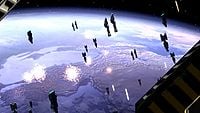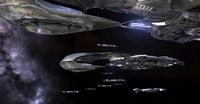Fleet: Difference between revisions
From Halopedia, the Halo wiki
m (Text replacement - "{{[Ee]ra\|[^}\n]*(Forerunner|Covenant|Human|UNSC|HCW|Post)[^}\n]*}}" to "{{Status|Canon}}") |
m (Text replacement - "{{Ref/Sources}} {{" to "{{Ref/Sources}} {{") |
||
| Line 55: | Line 55: | ||
==Sources== | ==Sources== | ||
{{Ref/Sources}} | {{Ref/Sources}} | ||
{{UNSC military organization}} | {{UNSC military organization}} | ||
[[Category:Fleets| ]] | [[Category:Fleets| ]] | ||
Revision as of 12:37, March 23, 2022
| There is more information available on this subject at Fleet on the English Wikipedia. |
A fleet is a large, permanent organization of ships including starships. Fleets are usually relatively large and manned by thousands of individuals on what is normally dozens or hundreds of ships. Smaller, more temporary groups of ships are generally known as battle groups.
Types
Human fleets
Historic
In 1573, Japan had a fleet of 133 ships which were destroyed by 13 ships. At a different time point, the United States of America also had a Pacific fleet at Pearl Harbor, which was eventually destroyed by Japan.[1]
UNSC fleets
- Main article: UNSC Navy
UNSC fleets are divided into Expeditionary and Defensive fleets. They are typically assigned to Sectors.[2] Sector fleets are usually commanded by a Vice Admiral.[3]
Defensive fleets
Defensive fleets are typically named after the star system they are based in. Prior to the Human-Covenant War, they were considered little more than glorified revenue police, though they proved invaluable in providing training cadres and battle-ready (if outdated) warships to the war effort. Defensive fleets are typically built around smaller "tactical" carriers serving as the fleet's core.[4] Known defense fleets include;
Expeditionary fleets
Expeditionary fleets are numbered fleets designed for offensive operations into deep space. These fleets were largely decimated in the early years of the Human-Covenant War, and by the war's end there was no appreciable difference between Expeditionary or Defensive fleets, and the navy was unable to conduct any kind of offensive operation without leaving Earth and the remaining colonies dangerously vulnerable.[2] During the period in which they were operational, Expeditionary Fleets built their cores around massive super carriers such as the Epoch-class heavy carrier.[4] Known expeditionary fleets include;
Dead fleets
By the end of the war, many of the Navy's fleets had also become "paper fleets", or "dead fleets", with no command and no ships. These fleets were assigned to sectors lost to the Covenant early in the war, with their destroyed squadrons remaining attached to the sector to honor their sacrifice and as deference for tradition. A new ship was occasionally inadvertently attached to one of these dead fleets due to bureaucratic error, though such assignments were considered ill omens by their crew members.[2]
Composition
UNSC fleets are comprised of numerous battle groups, smaller tactical formations of ships. Naval fleets rarely patrol together, and it is fairly common for single ships to patrol regions of space alone. Fleets are also comprised of squadrons, though by the end of the war these were administrative rather than tactical groupings.[2] Fleets, as with battle groups, usually have at least one prowler to act as the fleet's eyes and ears and to also serve as saboteurs.[5]
The UNSC also maintains the UNSC commercial fleet, which is not a military unit and instead fulfills the role of a merchant navy.[6]
| |||||||||||
Covenant fleets
- Main article: Covenant fleet
Covenant fleets are usually dominated by larger, more powerful ships. Covenant frigates are common in smaller fleets, however, there are usually far more destroyers and cruisers suited for plasma bombardment. Covenant fleets are essentially self-sustaining armadas, capable of operating without supply for indefinite periods thanks to their use of agricultural support ships.[7] Like Covenant ships, fleets are also given different designations mostly pertaining to religious nomenclature. Larger Covenant fleets typically contain thousands of ships, most of them CCS-class battlecruisers and groups of CAS-class assault carriers.[8]
Large Covenant fleets are usually commanded by a Fleet Master or a Supreme Commander.[9] Although, some small fleets are commanded by a singe Shipmaster.[10]
Forerunner fleets
- Main article: Forerunner fleet
Fleets were a basic unit of organization in the Forerunner ecumene's military forces. Throughout Forerunner history, most fleets fell under the authority of the Warrior-Servant rate, but after their reduction at the hands of the Builders, Builder Security became the dominant military organization. Forerunner fleets were under the authority of Fleet Command.[11][12]
Gallery
The UNSC Home Fleet engages the Fleet of Sacred Consecration over Earth.
The Fleet of Retribution.
A Forerunner naval unit battling the Flood.
Sources
- ^ Halo: Silent Storm, chapter 4
- ^ a b c d Halo: Fleet Battles, Core Rulebook - page 9
- ^ Halo: Official Spartan Field Manual, PART 8: UNSC ORGANISATION, NAVCOM Ranks (p. 140-141)
- ^ a b Halo: Warfleet, p.40-41
- ^ Halo: Ghosts of Onyx, page 329
- ^ Halo: Contact Harvest, page 96
- ^ Halo Graphic Novel, p. 15
- ^ Halo Encyclopedia (2009 edition), page 276
- ^ Halo: Ghosts of Onyx, page 243
- ^ Halo: Evolutions - Essential Tales of the Halo Universe, "The Return"
- ^ Halo 3, Terminals
- ^ Halo: Silentium, page 197
| |||||||||||


